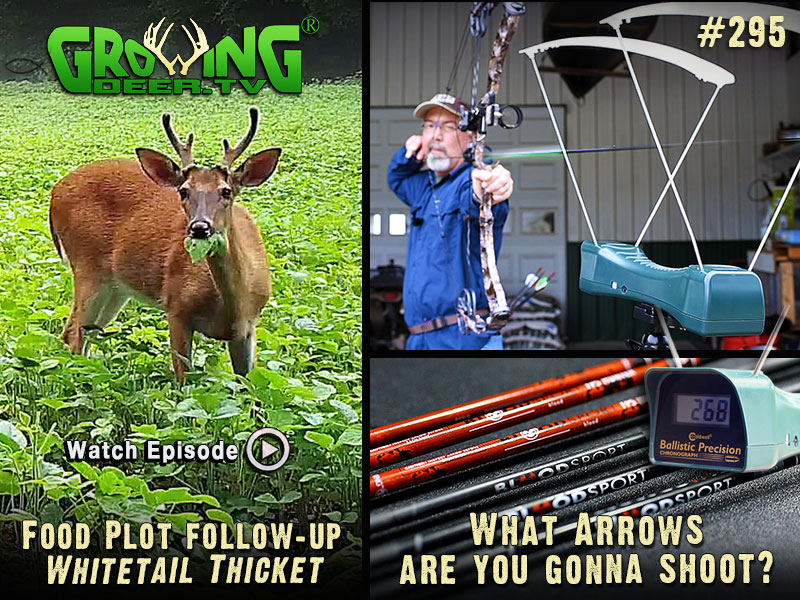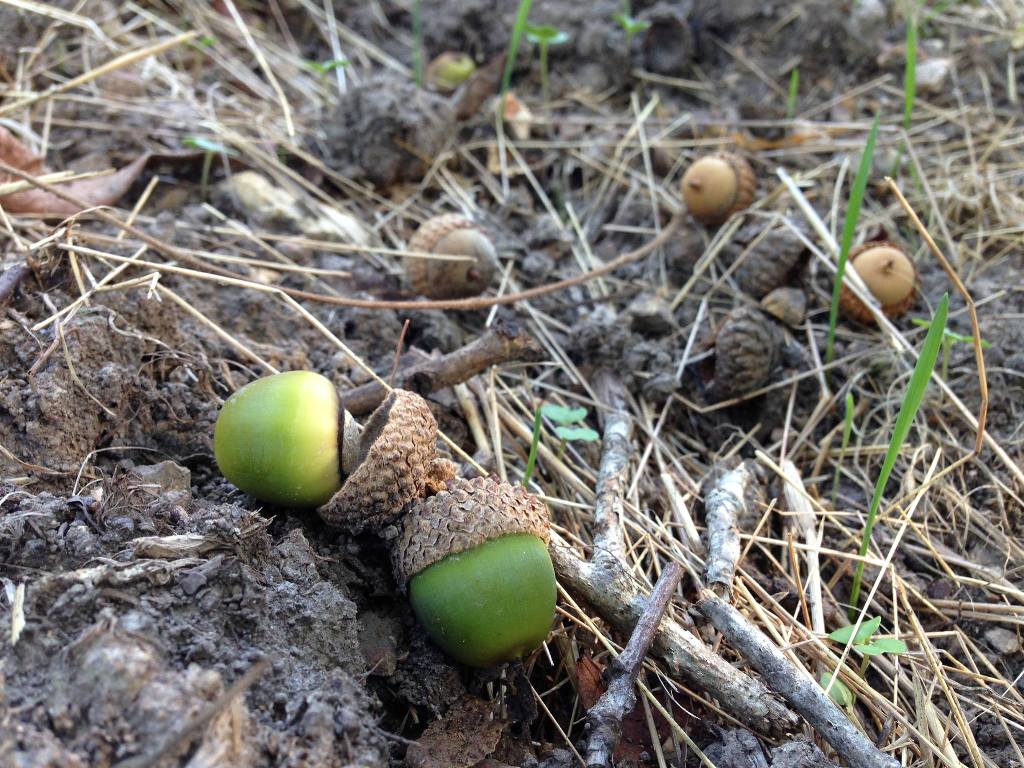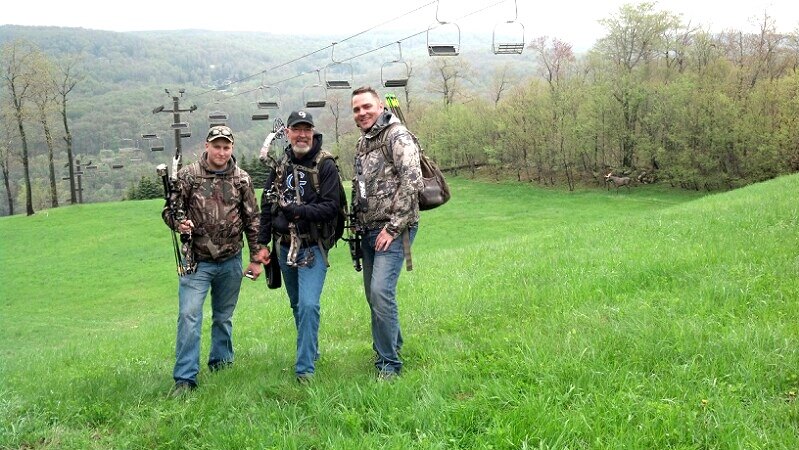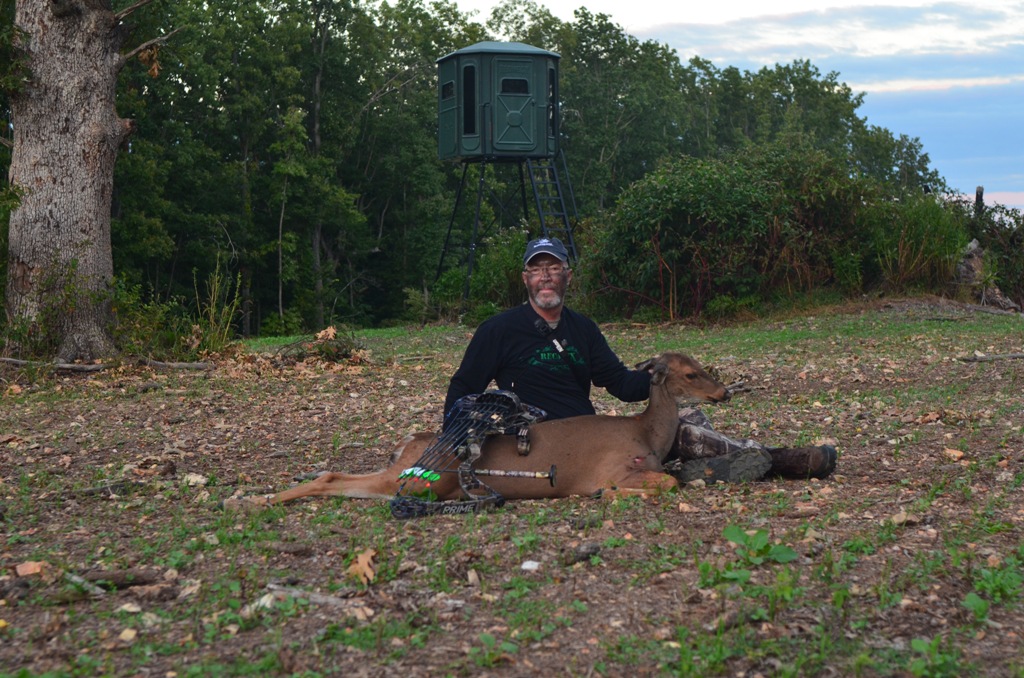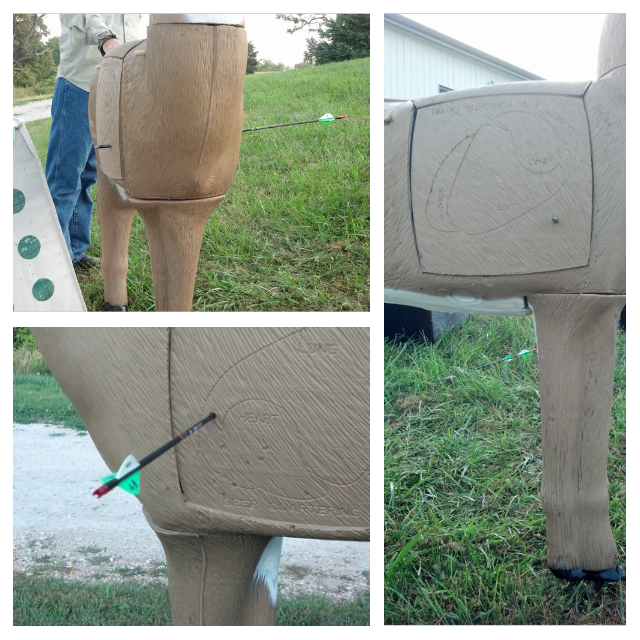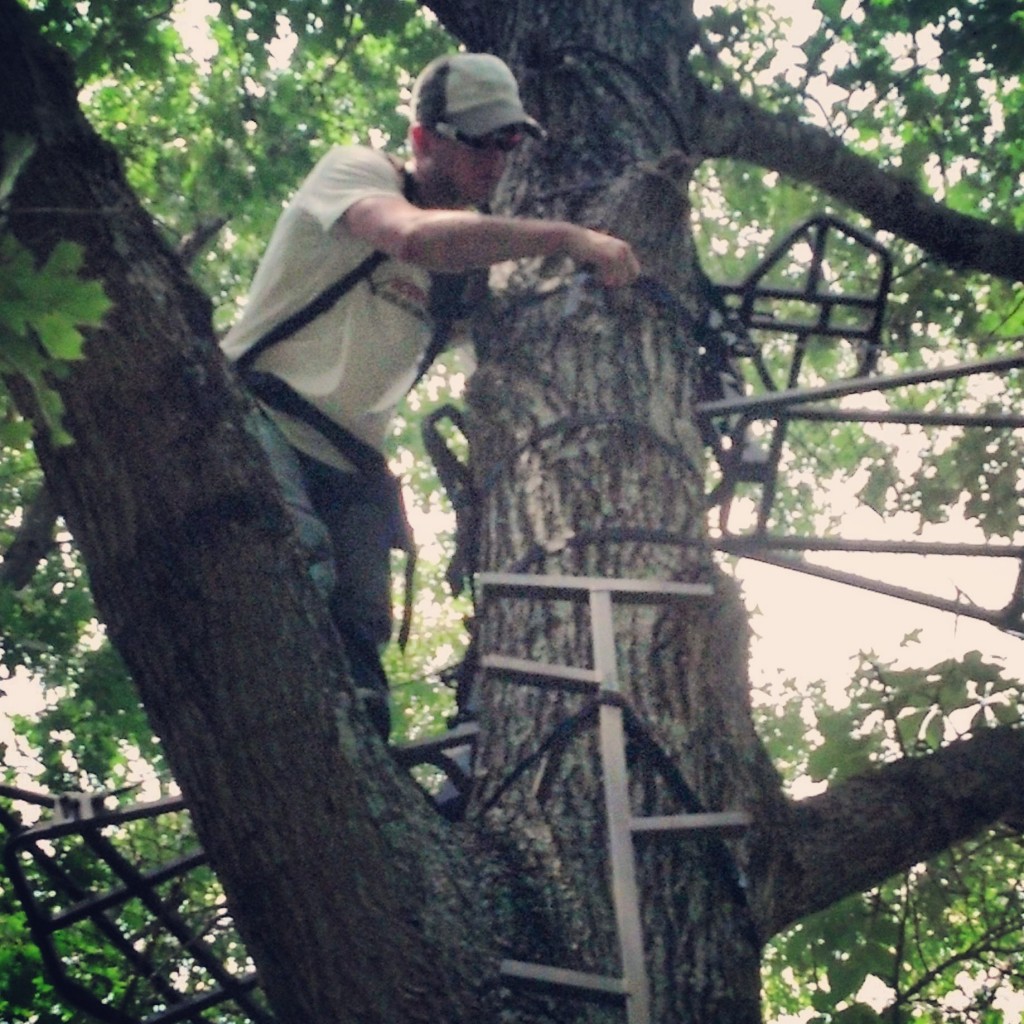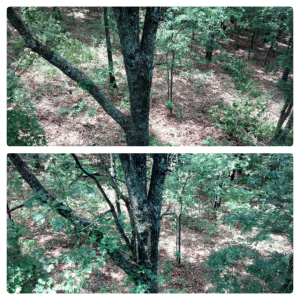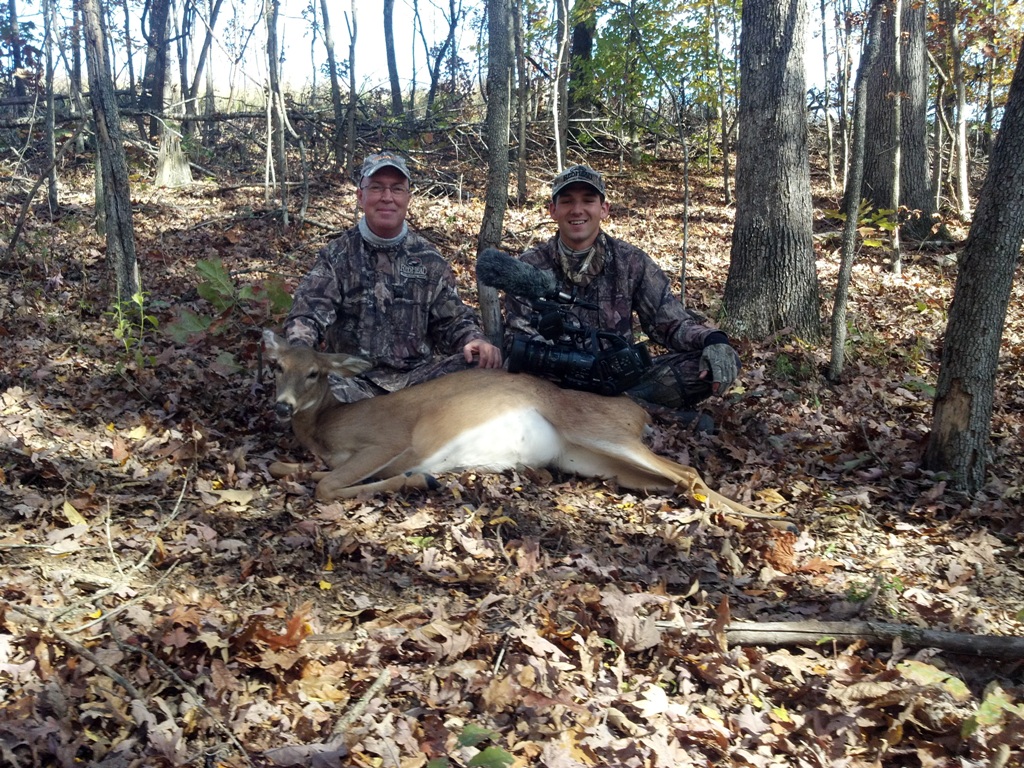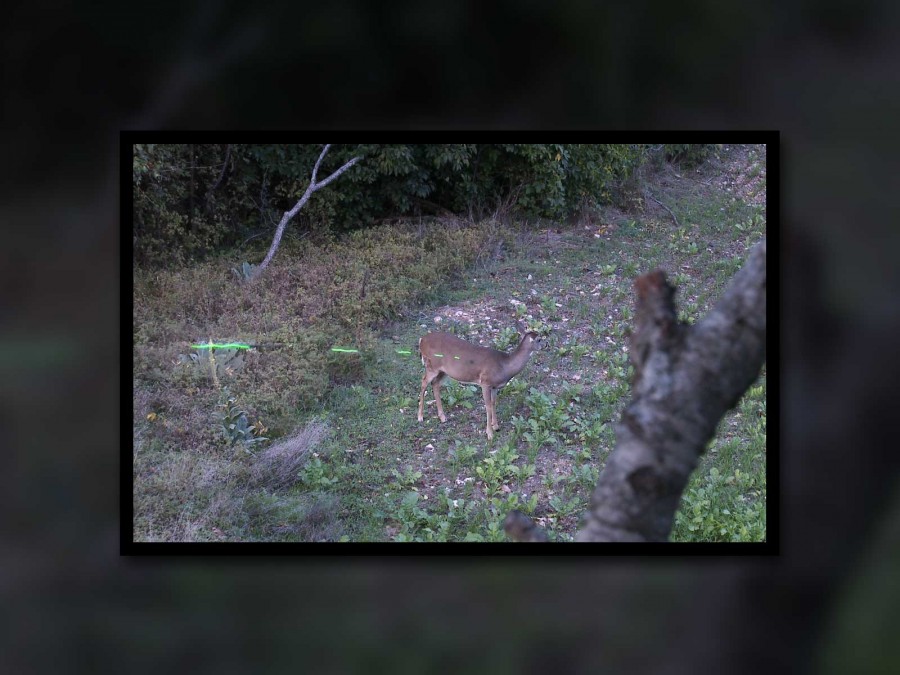Category: Bow Hunting
Arrow Speed – Episode #295
Which arrows are you gonna shoot this fall? Lightweight for speed or heavy for punch power? Watch Grant test both types and make his decision.
Captured! Adam placed a Reconyx UltraFire in a bean field and got great video of deer absolutely mowing the beans. Plus, Grant does a food plot follow-up in our Whitetail Thicket soybean field – a promising variety for small food plots!
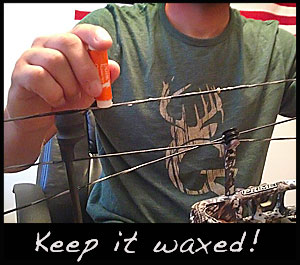 Tip of the Week:
Tip of the Week:
Summer sun and heat will take a toll on your bow string. Keep it happy, keep it waxed.
Staying Warm In A Deer Stand
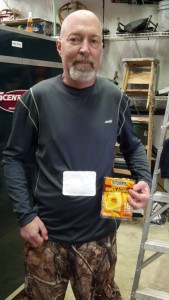
Grant attaches the HotHands body warmer in the center of his chest to keep warm on those later winter hunts.
Perched in a deer stand during the late winter months can be brutal, especially if your gear is less than equipped for the elements. Adding one small detail to your apparel can increase your comfort and your success.
During these cold winter months, it is very important to remain warm throughout your hunt. Sometimes, it seems almost impossible to stay warm and comfortable in the deer stand, but through years of perfecting our technique we’ve learned to never forget one piece of equipment. HotHands are a must for the GrowingDeer.tv team. These small, inexpensive packs are worth their weight in gold!
We use HotHands for several reasons – their heated insoles keep our feet warm, the hand warmers keep our hands warm, but most importantly we use their body warmers. The body warmers are definitely our favorite! Once we’ve put on our base layers, we attach the body warmer in the center of our chest just below our heart. Next we’ll place another body warmer in the center of our lower back. With the HotHands firmly attached to our base layer, we finish dressing and head to the stand. Staying warm throughout the hunt means you can sit longer, greatly improving your rate of success.
This small detail not only helps keep us warm but more importantly allows us to wear less clothes. In years past it was difficult trying to find the happy medium between wearing enough clothes to stay warm but not too many for fear of not being able to draw your bow back effectively. HotHands has certainly solved that problem!
If you’ve always struggled to stay warm while hunting, be sure to try this technique out!
Daydreaming of Whitetails,
Adam
Opening Day Challenges!
It’s only a few days before Missouri archery season opens up. Yes, you heard correctly, IT’S LESS THAN A WEEK AWAY!!! YAY!!! It’s a very exciting time of year for not only the bow hunters in Missouri, but for all the bow hunters across the nation! With bow season opening up soon, it’s time to start thinking through where we’re planning on hunting.
Like late season hunting, it’s about finding the food source. Whether that is a soybean field, a white oak grove with freshly dropped acorns, or an Eagle Seed Broadside blend, these can all be early season hot spots. Here in the Ozark Mountains, we are dominated with trees and not just trees; we’re dominated with oak trees. Red and white oaks are everywhere! Some years over 80% of the oaks can be carrying acorns and dropping them throughout the season. This makes it very difficult to pattern not just mature bucks, but does as well.
That’s why it’s very important to know your property. Are there acorns? Is there a soybean/corn field deer are frequently using? We had a late frost in this part of the Ozarks and thought there wouldn’t be many, if any, acorns this year. We were wrong about that. Grant and I have been watching the acorns form on certain trees throughout the summer. Not all of the oaks have acorns. We estimate only 40 to 50% of them have produced acorns. This means Grant and I will be taking a few scouting excursions trying to find that one oak that is dropping acorns and the deer are hammering! In our area, acorns have been the primary food source since deer populated the area way back when. This hasn’t changed even after highly craved soybeans have been planted across The Proving Grounds year after year. Acorns are king when they’re falling.
With all that being said, Grant and I will be watching the Reconyx cameras and slipping on the LaCrosse boots the next couple of days trying to find a pattern so we can have a successful hunt on Monday for Missouri’s opening day!
Be sure to know the food source in your area so when opening day gets here, you have a plan and you can succeed!
Daydreaming of whitetails,
Adam
Bow Hunting: Perfect Practice Makes Perfect
Turkey season has closed in several states across the nation. What’s next for the GrowingDeer team? We’ve got a busy summer planned with lots of management projects! We’ll focus our time on our food plots both new and old, tree stand preparation, and most importantly, prescribed fire. With all the summer projects planned there is one activity that can’t be overlooked. It’s very important for each of us that participate in bow season to practice shooting throughout the year and not just the few weeks before season opens.
Now let me define “practice.” Some hunters will practice this off season competing in 3-D tournaments. Others will head indoors for archery tournaments where they practice shooting targets with an “X” on a piece of paper. These are great ways to get you ready for the upcoming archery season but it’s even more important to do “perfect practice.” Perfect practice isn’t the act of shooting your bow over and over at one target and saying you’re ready for season. Perfect practice is getting as close to a real hunting setting as possible. If you hunt in a hat, you shoot in a hat. If you wear binoculars around your neck while hunting, you practice with binoculars around your neck. If you hunt from ground blinds, you practice from ground blinds. These are only a few different examples of perfect practice but all practice should be done with the same equipment that you’ll use hunting and the same mechanics. Same anchor points, same way gripping your bow, same body position, same focus. When we practice, we’re trying to imitate what we’ll be doing this fall when we’re hunting, so we’re getting as close to that as we can when we practice.
Another way of improving our practice and ultimately our shooting ability is practicing from farther distances. Those of you that have shot at long distances like 80 and 90 yards know how incredibly easy it seems when stepping in to real hunting distances of 20 and 30 yards. Unfortunately not everyone can shoot at these distances in their yard. To solve that problem Grant and I recently returned from Seven Springs Resort in Pennsylvania where the Prime Total Archery Challenge was held. This archery Challenge is not for the faint of heart but it’s very close to real world hunting settings. There are several courses with over twenty targets on each course from distances of ten to over 90 yards! All of these targets are in different locations with different angles and slopes. Practicing in conditions like this will unquestionably make you a better shot and inevitably a more successful hunter!
For more information on the Total Archery Challenge go to http://totalarcherychallenge.com/.
Hopefully the weather isn’t too hot where you live this week and you get a chance to practice for the upcoming deer season! It’s only a few months away!
Daydreaming of giant whitetails,
Adam
Bow Hunting Whitetails: How To Select The Best Broadhead
Bow season is open or opens very soon in most states. Many hunters have been planting food plots, scouting, practicing with their bows, etc. During all this activity and excitement, don’t forget the point (pun intended) that determines if all this activity results in fresh tenderloins or tag soup! I’m referring to broadheads!
Broadheads kill deer by causing rapid blood loss. The more rapid the blood loss, the shorter the trail. Most reviewers of broadheads seem to focus on the amount of cutting surface and how straight it flies. These are certainly important characteristics. Another characteristic that’s very important to obtaining venison is the sharpness of the broadhead! I wrote about that a few weeks ago in a post titled Why Every Hunter Should Want The Sharpest Broadhead.
Sharp broadheads are very important! However, sharp is only good if the broadhead is strong enough to stay together as it passes through the critter. A deer’s vitals are protected by ribs and a shoulder bone. Rarely do deer present a perfect broadside shot so it’s often likely that a broadhead will enter through the ribs and need to exit through the shoulder bone.
This requires a very strong broadhead to retain its shape and function as designed. I tend to always hug the shoulder tightly with my aiming point. If the deer is quartering away from me at all such an aiming point will result in an exit through the shoulder bone.
I shot a doe that was quartering away at a steeper angle than I thought yesterday afternoon and the G5 Striker head made a perfect triangle hole in the off shoulder bone. The trail was easy to follow and there was fresh venison laying less than 100 yards from the Redneck Blind where I was hunting.
I hope to make the perfect shot each time. That’s not realistic. That’s why I suggest all hunters use a very sharp broadhead that is strong enough to penetrate bone and result in a good blood trail.
Growing and hunting deer together,
Grant
Deer Hunting: Realistic Practice Puts Tenderloins In The Freezer
I enjoy shooting both guns and bows! I was raised by a family that shot competitively. My father, mother, and both sisters and I have won numerous shooting matches in the National Muzzleloader Rifle Association’s competitions. I give all the credit for the wins to my father, Glen Woods.
My dad always had us practice in the same positions, at the same ranges, and at the targets we’d see at the upcoming matches. He’d also mix in some fun, like shooting at novelty targets.
The skills I learned as a child while being “coached” by my father have helped me through the years. However, just the knowledge of how to shoot won’t put many tenderloins in the freezer without continual practice.
I believe it is just as important for hunters to practice shot placement as it was for me as a competitor to practice with the exact conditions I would see during matches! A great method to do this is to practice using 3D targets! It’s very easy to focus on where the arrow/bullet strikes the target, especially paper targets. To consistently bring home tenderloin, knowing where the arrow/bullet exits is as important as the entrance.
To take this a step further, I like to practice with the broadheads and bullets I use to hunt with. Finally, I like to simulate the conditions of shooting at a critter versus practicing quietly by myself. I often have my buddies shoot with me and encourage them to be talking, teasing, etc., while I’m shooting.
Finally, I continue practicing during season. It’s easy to practice all summer and be shooting great at the first of the season. However, it’s easy to spend all of our free time hunting once season begins. As the temperatures change most hunters will wear different/more clothes. This can radically change the sight picture of shooting a bow and/or gun. In addition, muscle tone developed by frequently practicing with a bow can decrease substantially in a few weeks if the practice frequency or duration decreases.
I’ve been practicing with my hunting gear, and will continue practicing throughout the season. How about you?
Growing and hunting deer together,
Grant
Bow Hunting Tips: Why Every Hunter Should Want The Sharpest Broadhead
Hunting archery equipment is designed to cause massive blood loss – quickly. This results in a humane kill with minimal suffering and stress to the game and better quality meat for the hunter. However an arrow passing through the vitals of a critter doesn’t necessarily result in massive blood loss – especially external blood loss that leaves an easy trail to follow.
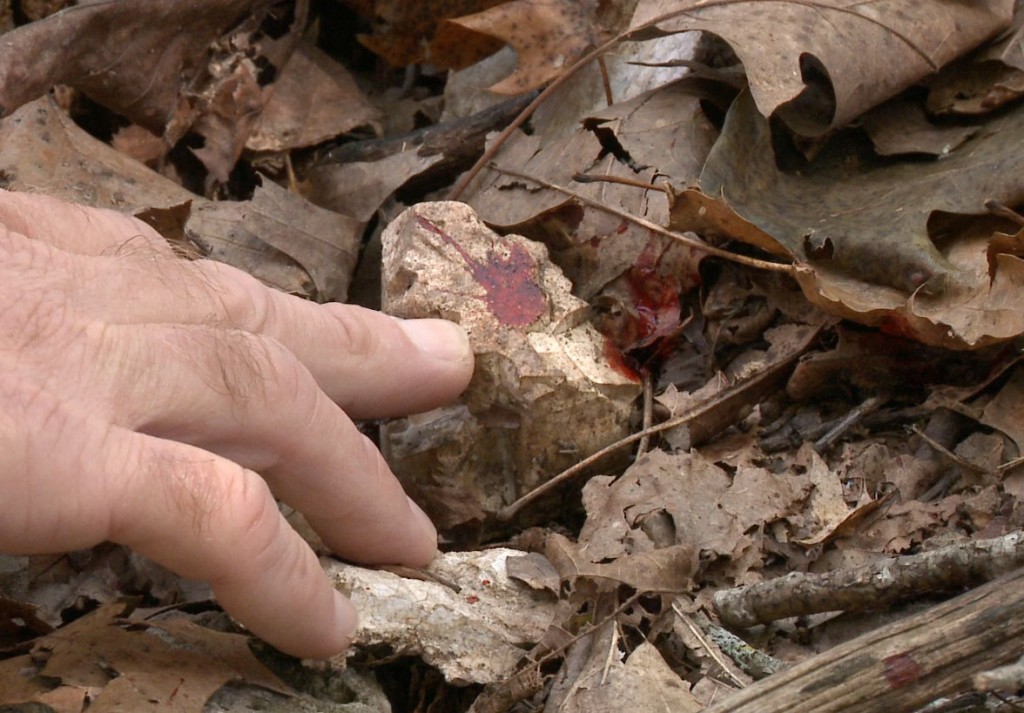
As a bow hunter I use the sharpest broadhead that flies straight from my bow and results in total penetration, a G5 Striker.
Have you ever heard of the hormone Thromboplastin? It’s known as the clotting hormone. It is released in deer (and humans) if the critter senses trauma. Wow – this is getting technical.
An easy way to understand the clotting hormone is to think back on when you had a paper cut. It’s usually tough to stop the bleeding from a paper cut. That’s because there is no or very little trauma and therefore no Thromboplastin is released.
On the other hand, when you mash your thumb with a hammer, etc., the bleeding usually stops rapidly. That’s because the body senses trauma and releases the clotting hormone.
The sharper the broadhead the less likely the critter will release the clotting hormone so the blood will flow freely without clotting. This is the primary reason I only hunt with the sharpest broadheads I can find.
My broadhead selection is based on good arrow flight (if it doesn’t hit the mark the sharpness doesn’t matter) and secondly the sharpness. I’d much rather have a smaller and very sharp cutting surface that results in less trauma than a larger cutting surface that results in a lot of trauma (which will cause the release of the clotting hormone).
I’ve tried several broadheads and have found G5’s Striker to be the sharpest. I’ve had great results with this broadhead on bucks!
Remember that bullets are designed to kill due to massive structural damage where broadheads kill as a result of blood loss. The best tool to insure rapid loss of large quantities of blood is by using the sharpest broadhead that flies straight from your bow and results in total penetration.
Just as every bow hunter spends hours practicing for the kill shot he/she should also carefully consider what’s on the business end of the arrow. My two criteria for a broadhead are that it flies straight and is extremely sharp.
Growing and hunting deer together,
Grant
Deer Hunting Tasks: Why Trim Shooting Lanes During June?
We’ve been hanging Muddy tree stands this week. It’s hot in Missouri here, with heat indexes over 100 degrees. We posted a picture of us while hanging stands on the GrowingDeer.tv Facebook page and someone responded “Why trim shooting lanes during June?”
That’s a good question! We primarily hunt our farm each year. We are constantly working on food plots, sanctuaries, Trophy Rock stations, trail camera surveys, shed hunting, etc. We continue learning how deer use this property during different conditions.
So we usually move some stands each year and/or trim different shooting lanes for existing stands. Hanging stands and trimming shooting lanes is hot, sweaty, noisy work. Mature bucks have some level of memory. In addition, it appears fear is their biggest motivation! It’s easy to see how mature deer could associate a stand location with fear if they experience loud noises and odors they associate with danger.
Therefore I prefer hanging stands and trimming shooting lanes as soon as the vegetation has grown most of what it will for the summer (new growth on trees is mostly complete by mid June). This means I won’t have to re-trim shooting lanes again during the fall and the area will have had months of no disturbance before hunting season.
If I wish to hang a stand during hunting season, I limit the amount of disturbance and vegetation trimmed to the minimum necessary to see and shoot. Excess disturbance during hunting season can substantially reduce the chances of harvesting a mature buck from that stand – no matter how hot the sign was that prompted you to hang at that location.
Remember, fear is probably the biggest motivation for mature bucks. Limiting disturbance near stand sites is critical to successfully harvest mature deer year after year.
Growing (and hunting) Deer together,
Grant
Deer Activity – Moon, Rut, or Weather?
I just shot a doe three hours before writing this. I saw her and a yearling buck. They were feeding on acorns. It’s October 25th and I’ve been hunting with three other guys for three days. None of us have seen a mature buck. I think it’s easy to explain why. The temperature each day has peaked at 80+ degrees.
I’m sure there will be some that will say deer are breeding late due to the drought, etc. However, that’s not the case. Years ago several researchers and I compared 1,000’s of conception dates collected from does harvested during the late season. The data was collected over several years and represented several states.
The strongest factor that predicted when the rut occurred was when it took place the previous year – not the phase, declination, etc., of the moon or any weather pattern. Timing of deer breeding is based primarily on genetics – not day to day factors.
Timing of breeding and daytime deer activity are not necessarily related. Several of my buddies have arrowed some whopper bucks during the past week in the western states – where the temperatures have dropped below normal. I was hunting at The Kentucky Proving Grounds early this week where the temperatures have been above normal. Even though the deer herd at The Kentucky Proving Grounds is a well managed deer herd, even healthy deer remain inactive during days with high temperatures.
From 20+ years of keeping records, there’s a strong trend that once deer start putting on fat along with their winter coat they simply don’t like moving during daylight, especially when the temperatures are above normal during daylight hours – no matter the date on the calendar.
I hunt when I can, but I expect more success when the daytime temperature is 10-20% below normal. I watch the weather forecast much more than moon phases or the state of the rut. The daytime temperatures are predicted to drop 30 degrees the next couple of days. I’ll let you know next week if the big bucks begin moving during daylight after the temperatures drop!
Growing (and hunting) Deer together,
Grant
Bow Hunting Whitetails: String Jumpers
It’s early in the 2012 bow season. October 1st Brian and I went to a stand we call Boom North. It hadn’t been hunted this year (or most of last year). Using the Reconyx time lapse feature, we had a pattern of deer entering the food plot by the stand and the wind was predicted to be favorable that afternoon.
I told Tracy (my wife) that I’d be late as I expected to tag a deer that afternoon. Once in the stand, Brian and I noticed the winds were swirling. We’ve come to trust our scent control system as we’ve had some great experiences already this year (GDTV 149).
We’d only been in the stand about 20 minutes when I heard a deer behind us in the forest. Brian and I caught a glimpse of a deer through a hole in the treetops (the ridge slopes down steeply from the stand). It took more than 10 minutes for the first deer to enter the field. Either our scent was going over the deer or our scent control was working perfectly!
The doe held up just behind a limb blocking a clean shot. During the next 10 minutes four more deer entered the plot. None of them offered a broadside shot. Brian and I were in ready posture for 38 minutes before we had the option of a broadside shot. The doe was head down and eating when I drew. She was 31 yards away and seemed relaxed.
When I released the Muddy BloodSport arrow and watched the green Nockturnal nock speeding toward the doe, I had the same feeling as when you shoot a basketball and know you ripped the net long before the ball gets to the goal. Then, in disbelief I watched the doe drop and my arrow just miss the top of her back. All deer scattered and my confidence drained.
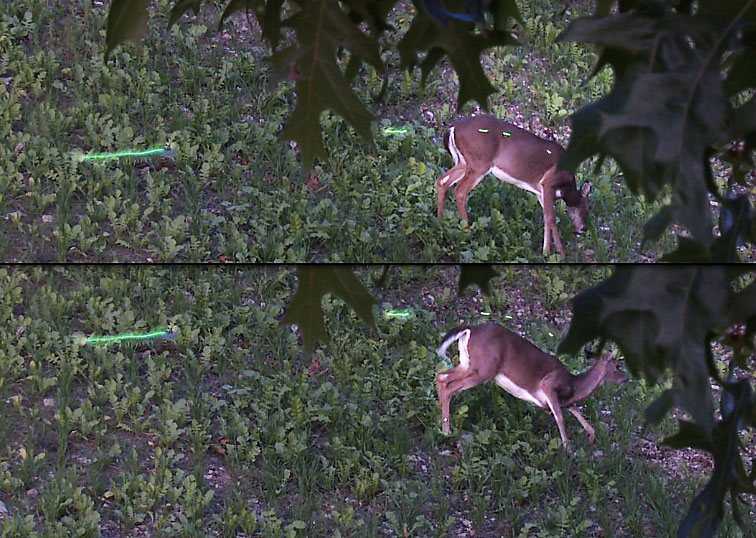
The top shows where the arrow would have been had the doe not dropped. The bottom shows what actually happened.
About ten minutes later one of the does returned to the plot. When she offered a 22 yard broadside shot, I tried again. That resulted in a short drag and tenderloins in the freezer! What was the difference?
The speed of sound is about 4 times faster than my bow shoots an arrow. Hence, if the deer is alert and reacts to a sound, they typically drop their body to prepare to sprint from the source of the sound. If you watch the video, you will notice the doe didn’t start dropping until the arrow was well under way. After being within 40 yards of two hunters for more than 30 minutes the doe was alerted by our presence. I’m amazed she hadn’t busted us earlier given the swirling winds. Once again the scent control system we use seems to be working!
The first doe apparently was alert enough to react to the sound of my bow and obviously had ample time to react and dodge the fate of becoming tenderloin for the Woods family. This was a great reminder to not shoot at deer that seem alert with a bow. Unless you are shooting the fastest bow on earth (1,100+ feet per second) deer can dodge the arrow – or worse yet, cause the arrow to hit a non-vital zone.
Tracy wants more tenderloin for the freezer, so I’ll be back in a tree soon – making sure to not shoot at deer that are alert.
Growing Deer together,
Grant



